
If you want the softest and most fancy knitwear in 2025, cashmere is special. Cashmere is popular in the ‘quiet luxury’ style. People love how soft, warm, and light it feels. In the debate of Cashmere vs Merino Wool, it’s important to note that merino wool is also comfy, allows air to flow through, and stretches well. Cashmere costs more, but merino wool is good for many uses. Here is how people see these materials:
Material | Key Attributes | Consumer Willingness to Pay |
|---|---|---|
Cashmere | Unparalleled softness, warmth, lightweight feel | High premium due to limited supply and labor-intensive production |
Merino Wool | Fine texture, breathability, natural elasticity | Valued for versatility and comfort, suitable for various climates |
You can pick what works best for you. The choice between Cashmere vs Merino Wool depends on what you want most.
Key Takeaways
Cashmere is very soft and warm. It is great for fancy sweaters. Pick cashmere for special days or when you want to look nice.
Merino wool is good for many things. It lets air pass through and is good for daily use. It pulls sweat away and keeps you dry in different weather.
Think about how to clean them. Cashmere needs gentle washing and careful handling. Merino wool is easier to clean and you can often use a washing machine.
Merino wool is better for the planet. It uses less water and land than cashmere. Choose certified merino wool to help the environment.
Mixing cashmere and merino wool gives you the best of both. You get a soft feel and strong fabric for a lower price.
Main Differences
Cashmere Overview
Cashmere is a fancy fiber. It comes from goats in cold places like the Gobi Desert. People collect cashmere in spring. Goats shed their soft undercoats then. Workers comb the goats gently. They gather the fluffy fibers. Next, they remove rough hairs. This step is called de-hairing. The result is a very soft and light material.
Cashmere is warmer than other wools. A thin cashmere sweater keeps you cozy. The fibers are fine and smooth. They feel nice on your skin. Many people like cashmere for comfort and warmth. But cashmere is delicate. You must wash it by hand or use a cleaner. If you want something special and elegant, cashmere is a great choice.
Merino Wool Overview
Merino wool comes from merino sheep. Most of these sheep live in Australia. Farmers shear the sheep to get the wool. This is not the same as collecting cashmere. Merino wool fibers are thicker than cashmere. But they are still soft and comfy. Merino wool stretches and moves with you. This makes it good for active wear.
Merino wool keeps you warm. But it is not as warm as cashmere. It lets your skin breathe. It also wicks away sweat. You stay dry and comfy all day. Merino wool is easy to care for. You can wash it at home. If you want something useful and flexible, merino wool is a smart pick.
Here’s a quick look at the main differences between these two fibers:
Feature | Cashmere | Merino Wool |
|---|---|---|
Source | Goats (Gobi Desert, Central Asia) | Merino sheep (Australia) |
Warmth | Warm, but less than cashmere | |
Softness | Extremely soft and fine | Soft, but less than cashmere |
Durability | Less durable, prone to pilling | More durable and elastic |
Comfort | Ultra-soft, lightweight | Comfortable, flexible |
Care | Needs gentle or professional cleaning | Easier to wash and maintain |
Cashmere vs Merino Wool
Fiber Micron & Texture
When you compare cashmere and merino wool, you see they feel different.
Cashmere fibers are between 14 and 19 microns wide.
Merino wool fibers are between 17 and 25 microns wide.
Smaller microns mean the fabric feels softer. Cashmere fibers are about 18 microns, close to superfine merino. This small size makes cashmere clothes very soft. Merino wool also feels soft, especially if the fibers are under 24 microns. Regular wool is much thicker and can feel itchy. Both cashmere and merino are natural fibers that feel nice on your skin.
Softness
If you want the softest feel, cashmere is the winner. People say cashmere feels silky and fancy. Merino wool is soft too, but a little rougher. Both are much softer than regular wool. Science shows cashmere’s fine fibers make it extra plush. Here’s some research to check out:
Study Title | Focus | |
|---|---|---|
Looks at the details of cashmere and merino wool | ||
Fibre properties affecting the softness of wool and other keratins | Talks about what makes wool soft | |
Set in Bending of Australian Cashmere and Superfine Merino | Studies how cashmere and merino bend |
You can feel the difference when you touch cashmere or merino wool. Cashmere feels like a luxury fabric. Merino wool feels soft and cozy.
Warmth
Cashmere is known for being very warm. Cashmere is warmer than merino wool. The thin fibers hold heat well. Cashmere clothes are about 7-8 times warmer than merino wool. If you need something for cold days, cashmere keeps you warm without being heavy.
Merino wool also keeps you warm, but not as much as cashmere. Merino fibers have tiny waves that trap air. This helps you stay comfy in cold or wet weather. Merino wool is great for outdoor fun because it keeps you warm, even if it gets wet.
Tip: Pick cashmere for city life or special events. Choose merino wool for hiking or sports.
Durability
If you want clothes that last, merino wool is better. Merino wool can handle more use and lasts longer. Most wool clothes can be worn about 79 times by the first owner and up to 109 times total. Cashmere is softer and more delicate. It can pill or wear out faster if you don’t care for it.
Pilling happens more with soft, thin fibers like cashmere.
Merino wool is thicker and pills less, especially if woven tightly.
Merino wool is a good choice for everyday wear.
Care
Both cashmere and merino wool need gentle care, but cashmere is fussier. Here’s how to keep your clothes looking nice:
Don’t use the dry cleaner—hand wash in cold water with mild soap.
Treat stains right away.
Lay flat to dry and shape it.
Use a sweater stone to remove pills.
Store in bags that let air in to keep moths away.
If you skip these steps, your cashmere or merino wool might lose shape or softness. Merino wool is a bit easier to wash, but both need gentle care.
Breathability
Merino wool is best for letting your skin breathe. Merino wool can soak up to 30% of its weight in water without feeling wet. This keeps you dry and comfy, even when you move a lot. Merino’s natural fibers help you stay cool or warm, depending on the weather.
Cashmere also lets air through, but it’s better at keeping you warm. For sports or changing weather, merino wool is the better choice.
Odor Resistance
Both cashmere and merino wool fight odors because they are antibacterial. Merino wool is the best for staying fresh. People say they can wear merino wool for days with no bad smell, even when traveling or working out. Wool fibers trap odors and let them go when you wash the clothes.
Fabric Type | Odor Retention (%) | Comparison to Polyester | Comparison to Cotton |
|---|---|---|---|
Wool | 66% less | Holds 66% less body odor | Holds 28% less body odor |
Polyester | Holds a lot | – | – |
Cotton | Holds some | – | – |
Cashmere also resists odors, but merino wool is best for staying fresh.
Sustainability
Caring for the planet is important in 2025. Both cashmere and merino wool are natural, but they affect the earth differently.
Cashmere uses a lot of water and land. It takes 3 to 5 goats to make one sweater, and uses lots of water.
Merino wool is more efficient. One sheep can make wool for 8 to 10 sweaters and uses less land and water.
Sheep make methane, which is a problem for merino wool. But new labels help. Look for the Responsible Wool Standard or Good Cashmere Standard. These show the farm is eco-friendly and treats animals well.
Cost
Price is a big deal when picking cashmere or merino wool. Cashmere costs more because it’s rare and hard to collect. You need several goats for one sweater. One merino sheep gives enough wool for many sweaters. That’s why cashmere is a luxury.
Cashmere sweaters cost much more than merino wool ones.
Merino wool is cheaper and still good quality.
Skin Sensitivity
If your skin is sensitive, you might wonder which is better. Doctors say superfine merino wool is safe for people with eczema and can even help. The fiber size matters—softer, finer fibers don’t itch. Cashmere is also gentle and rarely bothers skin. Both are good for sensitive skin.
Aspect | Details |
|---|---|
Study Focus | How superfine Merino wool affects eczema |
Conducted By | Division of Dermatology, University of Louisville |
Findings | Wearing Merino wool helped people with eczema feel better |
Recommendations | Superfine Merino wool is good for people with eczema and may help with mild to moderate atopic dermatitis. |
Best For Knitwear Types
Designers choose cashmere or merino wool based on style and use.
Cashmere is great for fancy pieces, winter scarves, and nice sweaters.
Merino wool is lighter and silkier, good for daily wear, sports, and layering.
If you want something fancy and super soft, pick cashmere. For sports, long-lasting wear, and value, pick merino wool. Both are natural fibers that give you comfort and quality, so you can’t go wrong with either one.
Blends That Maximize Value

Cashmere + Merino (80/20)
You might see more sweaters and scarves made with a blend of cashmere and merino. This mix gives you the best of both worlds. Cashmere brings that soft, luxury feel you love. Merino adds strength and helps your knitwear last longer. You get a cozy piece that feels fancy but stands up to daily wear.
The blend usually has about 20% cashmere and 80% merino.
You feel the warmth and softness from cashmere.
Merino makes the fabric more durable and easier to care for.
This blend costs less than pure cashmere but still feels special.
In 2025, more brands use this blend because people want luxury and value. You can spot these blends in new collections from top names like Johnstons of Elgin. They focus on high-quality, natural fibers that feel good and last.
Cashmere + Nylon (90/10)
Sometimes, brands add a little nylon to cashmere. You get a blend that is 90% cashmere and 10% nylon. Why do they do this? Nylon helps your sweater keep its shape. It also makes the knitwear less likely to stretch out or get holes.
You still feel the soft touch of cashmere. The nylon is there to make your clothes stronger. This blend works well for lightweight sweaters and travel pieces. You can pack them in your bag, and they bounce back to shape.
Tip: If you want a sweater that feels like pure cashmere but lasts longer, try this blend.
Merino + Cotton (70/30)
You might want something lighter for spring or fall. A blend of merino wool and cotton gives you that. Usually, it’s 70% merino and 30% cotton. This mix feels soft and smooth. It keeps you warm but not too hot.
Merino helps the fabric breathe and wick away sweat. Cotton adds a cool, crisp touch. You can wear these pieces all day, even when the weather changes. They work great for layering or for people who want a less fuzzy feel.
Recycled Cashmere
If you care about the planet, you should check out recycled cashmere. Brands collect old cashmere sweaters and turn them into new yarn. You get the same soft feel, but you help reduce waste.
Recycled cashmere uses less water and energy. It’s a smart choice if you want luxury and want to help the environment. Many luxury brands now offer recycled options, so you don’t have to give up style for sustainability.
Which One Should You Choose?
For High-end luxury designer
If you want your brand to be special, pick cashmere. It feels super soft and looks very fancy. People expect cashmere to be rare and high-end. Cashmere makes every item feel important. You can use it for cool sweaters or pretty scarves. Some designers even use cashmere for fashion shows. People like how cashmere hangs and shines. If you want your brand to look rich and quiet, cashmere is a good choice.
Tip: Mix a little merino wool with cashmere to make it stronger. You still get the soft feel but your clothes last longer.
For Everyday performance brand
You need clothes that are tough and last a long time. Merino wool is great for this. It stretches and lets air in, so you stay comfy. Merino wool is perfect for sports, travel, and daily wear. You can wash merino wool at home. It does not smell bad easily. People like that merino wool is soft and not itchy. If you want your brand to be useful and flexible, choose merino wool.
Merino wool is good for base layers, socks, and light sweaters.
It keeps you at the right temperature and is easy to wash.
For Sustainable fashion label
If you care about the earth, think about your materials. Merino wool is a green choice because one sheep gives lots of wool. You can also find blends with recycled merino or cashmere. These blends help you use less water and make less trash. People want to buy clothes that are good for the planet. You can show you care by using certified fibers and telling your story.
Material | Eco Benefit |
|---|---|
Merino wool | Renewable, efficient |
Recycled cashmere | Less waste, less water |
For OEM/ODM private label
You want choices and good prices. Merino wool lets you make many styles and keep costs low. You can mix merino with cotton or nylon for new looks. If you want to add some luxury, use a bit of cashmere. You can make different collections for all kinds of buyers. Merino wool helps you make more clothes and keep customers happy.
Note: Always check for certifications to help your brand look good.
Luxury Feel

Look and Texture
When you pick up a sweater, you notice how it looks and feels right away. Cashmere gives you a smooth, almost buttery touch. The fibers look fine and even. You see a gentle shine that makes the fabric stand out. If you run your hand over it, you feel softness that seems to melt into your skin. People often say cashmere feels like a cloud.
Merino wool has a different vibe. The surface feels soft, but you notice a bit more texture. Merino wool shows tiny waves in the yarn. These waves help the fabric stretch and move with you. You get a cozy feeling, but it does not feel heavy. The look is clean and modern. You can wear merino wool for work or play, and it always looks fresh.
Tip: If you want a sweater that feels light and smooth, try cashmere. If you like a soft touch with a little bounce, merino wool is a great choice.
Exclusivity
Luxury is not just about how something feels. It is also about how rare it is. Cashmere stands out because it is hard to find. Only a few goats make the right kind of fiber. You need a lot of work to collect and clean it. That is why cashmere sweaters cost more and feel special.
Merino wool is easier to get, but superfine merino is still a treat. Some brands use special sheep to make yarn that feels extra soft. You see merino wool in high-end stores, but it is also in everyday clothes. If you want something rare, cashmere is the top pick. If you want luxury you can wear every day, merino wool gives you that.
Feature | Cashmere | Merino Wool |
|---|---|---|
Rarity | Very rare | More common |
Price | High | Moderate |
Everyday Use | Special events | Daily wear |
2025 Trends
Market Trends
Luxury knitwear is changing quickly in 2025. People want clothes that feel good and work everywhere. This is called function-luxury. More shoppers pick merino wool because it feels soft and works all year. Cashmere is not just for winter anymore. Brands now make lighter cashmere for spring and summer.
Here are some big trends to watch:
Fashion is about comfort and style together.
Cashmere is now for every season, not just winter.
Merino wool is liked for being breathable and useful.
People care more about the planet. They look for eco-friendly labels and recycled fibers.
Holiday gifts make luxury knitwear popular, especially in December.
The knitwear market is growing fast. Experts think it could be worth $1.6 trillion by 2030.
Brands work on traceability and better fibers to follow new rules and keep buyers happy.
Note: If you want to help the earth, pick brands with recycled cashmere or certified merino wool.
Innovations
Technology is making luxury knitwear smarter and greener. New machines and ideas help brands make better sweaters and scarves. These changes mean your clothes fit well, last longer, and keep you comfy in any weather.
Here are some cool new things:
Innovation Type | Description |
|---|---|
Processing Innovations | New ways to make yarn and dye fabric use less water and energy. |
Machines knit clothes without seams, so there’s less waste and a better fit. | |
AI Pattern Design | Computers help brands create patterns that match what you like. |
Smart Textiles | Some knitwear can change temperature or track your health. |
Automation | Robots help make sweaters faster and keep the quality high. |
You might see sweaters made with 3D knitting that fit better and feel smoother. Some brands use AI to make patterns you like. Smart textiles can keep you cool or warm and even track your steps. Robots help brands make more clothes and keep them nice.
Tip: If you want cool new features, look for brands with smart textiles and seamless knitting.
It can be hard to pick between cashmere and merino wool in 2025. Cashmere is super soft and feels fancy. Merino is comfy, lets air in, and is good for daily use. You should think about what is most important to you. Do you want softness, care about the planet, or need something for every day? Choose the fiber that matches your style and life.
FAQ
Can you machine wash cashmere or merino wool?
You should not machine wash cashmere. Hand wash it gently in cold water. For merino wool, check the label. Some merino pieces are machine washable, but use a gentle cycle and cold water.
Does cashmere always cost more than merino wool?
Yes, cashmere usually costs more. It comes from rare goats and takes more work to collect. Merino wool is easier to get, so you pay less for it.
Which is better for people with allergies or sensitive skin?
Both fibers feel soft and gentle. Superfine merino wool works well for sensitive skin and even helps some people with eczema. Cashmere is also soft and rarely causes itching.
Tip: Always check for labels like “superfine” or “hypoallergenic” if you have skin concerns.
How can you tell if a sweater is real cashmere?
Look for these signs:
The label says “100% cashmere.”
The fabric feels very soft and light.
The price is higher than regular wool.
If you see “cashmere blend,” it means other fibers are mixed in.
Is merino wool good for summer?
Yes! Merino wool breathes well and wicks away sweat. You can wear it in warm weather. It keeps you cool and dry, so it works for summer, too.








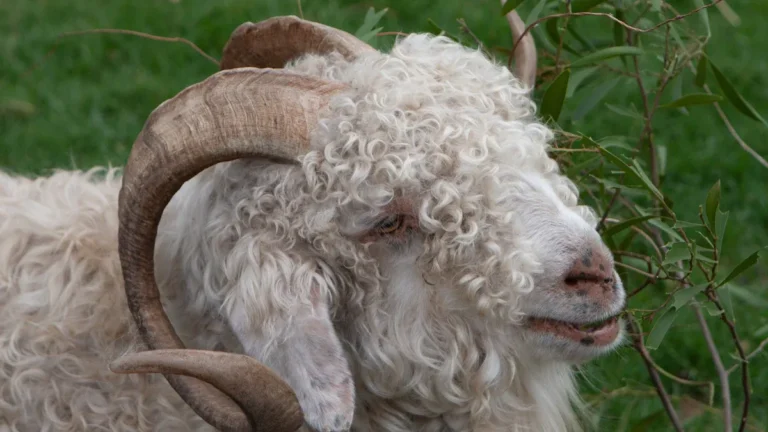

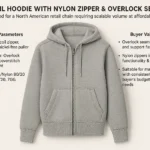
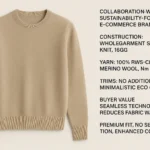



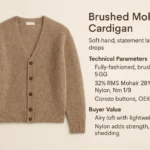
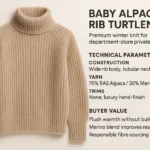
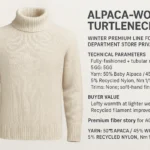
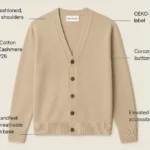
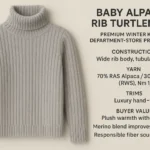
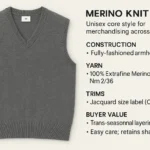
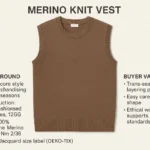
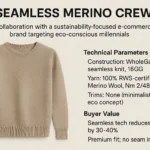

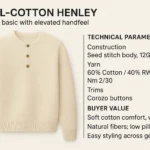
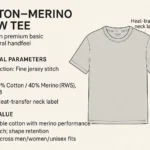
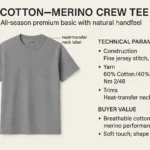

1 thought on “Cashmere vs Merino Wool: Which Is Better for Luxury Knitwear in 2025?”
Pingback: Comparing Polo Ralph Lauren and US Polo Assn for Style and Value